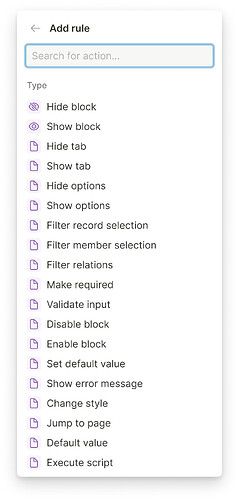It’s finally here. Something we’ve been dreaming about for over ten years. ![]()
After countless workarounds and creative hacks, we’ve now built it - fully native, deeply integrated, and beautifully simple to use.
Welcome, rules. 
After just a few days of testing, we’re already hooked.
What are rules?
Rules make your forms smart.
Instead of being static, smart forms are dynamic.
Rules let you control what people see, what they can do, and how blocks in your form behave - all based on simple logic you define. A common example: showing or hiding fields based on user input.
Rules will also work exactly the same in the upcoming new record.
To keep it simple, we used the proven structure:
When [condition], do [action]
That’s it.
After many great ideas from the community, we decided to build our own engine just for rules - as powerful as the one behind workflow automations, but designed for a different purpose:
- Workflow Automations: often change data, sometimes across multiple records
- Rules: control how a form looks or how blocks behave, without changing any field value
Why “Rules” and not “Conditional Logic”?
Rules don’t just respond to user input. Rules can also define how blocks behave by default. Some don’t even need a condition at all. Others include actions like validations, filters, or scripts.
That’s why we call them rules, because Tape’s rules go far beyond conditional logic.
Simple, powerful, and (we hope) intuitive.
What can you do right now?
- You can use rules on any block, from headers to images to field blocks.
- Available actions: show block and hide block
- Conditions: based on select fields (single select, multi-select, and status)
With this private beta, many of the most common use cases are already covered.
Here are a few ideas we might develop as future rule actions:
Tips & notes for building faster rules
- Use Cmd/Ctrl + Shift + L to lock or unlock the form
- In an unlocked form, you can test everything live. For example, hidden blocks appear grayed out when they’re hidden by a rule.
- Copying a block includes its rules
- Indicating an active rule by showing a purple dot indicator before the block
- Create a single rule on a box or group block to apply it to all blocks inside
How rules run
Rules and rule actions are checked from top to bottom.
In case of conflicting rules or rule actions, the last one wins.
Just drag and drop rules to change their order.
Going deeper, for experts
Rules support advanced logic:
- Combine multiple conditions with “And” all conditions must match
- Use “Or” when at least one condition must match
- Nest condition groups within each other
This allows you to create more complex logic, like:
“Show chairs, AND those chairs must be in stock OR show furniture made of reclaimed wood”.
Give it a try. Conditional groups start to make sense once you build one.
Community examples for rules
- Show or hide fields on a waitlist form
- Customize a client check-in based on their previous answers
- Make long forms easier by only showing what’s needed, when it’s needed
Thank you for your inspiration!
This was a complex challenge for our team. From the technical side all the way to making it incredibly easy to use. Now that rules are here, we’re excited about what they’ll unlock. It’s something we’ve all been waiting for a long time.
Rules will make forms and the upcoming new records more flexible, more powerful, and much easier to work with. Happy building.
